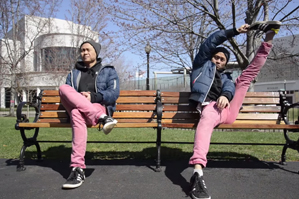Why sit? The case against chairs

I’m currently sitting at my standing desk as I write this after walking back from an interview on campus. I’m glad that I walked there–I could have just done it over the phone. But after meeting Wilfred Hsie, a fourth-year student in Northeastern’s College of Computer and Information Science, I wonder if I shouldn’t have danced my way over instead, if I shouldn’t be doing more than just sitting and standing at my convertible workstation. Maybe I should be spinning, squatting, and “sprinking” too. After all, Hsie said, there’s more than one way to interact with the infrastructures we’re used to.
A chair for example, elicits a typical response when we see it: sit down, butt on seat, back on back, feet on floor. But who’s to say I couldn’t “sit” with my head on the seat instead? Or, less dramatically, squat on it with my feet on the seat? Or butt on seat and one leg over head?
All these positions probably sound ridiculous, but why? Why don’t we approach our environment with more flexibility and freedom? And more importantly, why has movement turned into an isolated activity reserved for gyms and dance studios?
These are the kinds of questions Hsie asks in a short film he made for his Environment and Technology class with assistant professor Sara Wylie. “She asked us to look at some infrastructure and propose an alternative for how it could be used,” Hsie said. “That sent me off on a journey to understand what I do.”
You see, Hsie doesn’t always sit with his butt on the seat the way most of us do. As a kid in elementary school, he was always fidgeting, rubbing up against the cultural norm and getting in trouble for it. Over time he found other outlets for this energy–dancing, gymnastics, music. But then in Wylie’s class he realized that perhaps he didn’t need to stifle his desire to squat in a chair, or to dance-walk across campus, or to do a back flip off a concrete wall after running up its height, for instance. Through his work in Wylie’s class, he began to realize that perhaps the butt-on-seat paradigm is a learned habit, one that’s reinforced over and over by social and cultural norms, and that perhaps there’s actually value in pushing its boundaries. Perhaps it’s actually good for our bodies to move in more dynamic ways than the ones they’re used to.
“So there’s a way that society expects us to use a chair, and then there’s a way that when you start creating your own definitions you start to say ‘what way can I use this chair that gives me the most creative satisfaction?'”
Creative satisfaction and internal peace were two things that came up repeatedly in our conversation. Our workaday lives keep our butts in seats in front of computers on desks behind cubicle walls. Hsie thinks that patterns like this make it harder for us to remember our bodies, to be able to recognize when they need to stretch or run or jump. He recommended every now and then just taking a deep breath and tuning into the internal body, asking it what would feel right in this moment. If a squat feels right, then so be it. Who cares if the people around you give you funny looks? Maybe you’ll just inspire them to go home and do the same thing.
While I’m probably not going to start sprinking at my standing desk any time soon, the idea of interacting with my environment in more ways than those that are traditionally expected has been intriguing me ever since I watched Hsie skateboard off into afternoon sun last week. I probably won’t start dance walking to my on-campus interviews, but I may just squat on my chair this afternoon, just to see how it feels.





